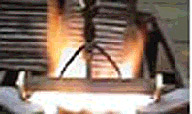By
the use of intense heat of oxy-acetylene flame, just a thin layer at
the surface of a part is rapid heated to a temperature above the
critical and then quenched by the double action of a water spay upon
the surface and the conduction of the heat into the cold base metal.
When such a part is quenched only the
surface layer is hardened.
The remainder of the part retains its
original toughness.
All flame hardening is accomplished as
has been described by heating the surface of the part with
oxy-acetylene flame until the surface is bright red - mild steel about
850 °C.
The normal pearlitic structure of the
steel is first converted to austenite in passing through the critical
temperature range, but rapid quenching prevents the reverse process
and the steel layer is held in a martensitic state. This layer of
about 3 mm is the hardest state possible for steel, offering a surface
protection without affecting the main body.
Because the parts to be hardened may be
round, flat or irregularly shaped, the mechanical arrangement and the
movement of the flame and quench varies in accordance with the shape
of the part being treated.
Burner design is important as well as
the hardening method to be used, such us Spot, Progressive, Spinning
or Progressive-Spinning.
Contact us about the method and
arrangements to better perform your job.
